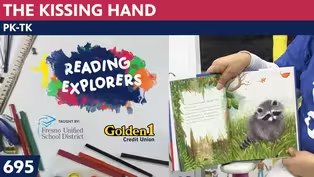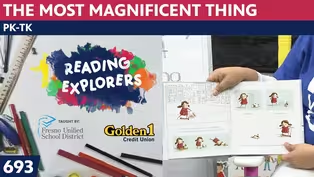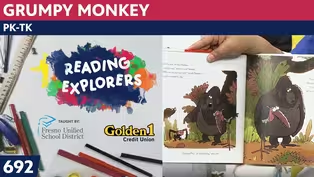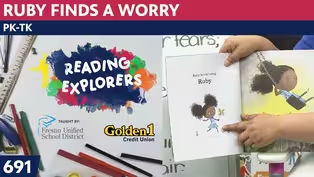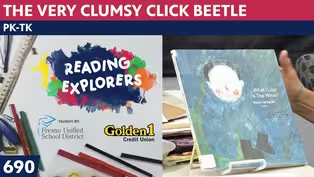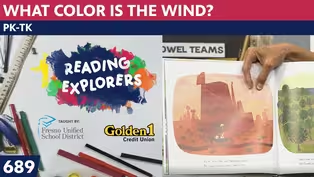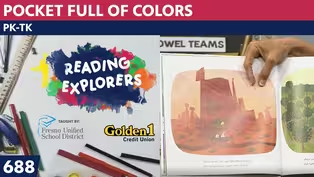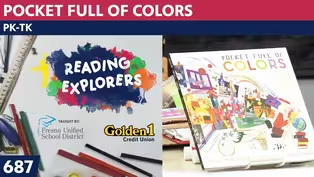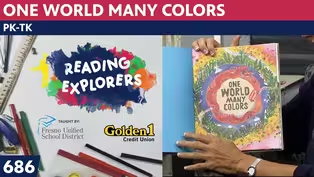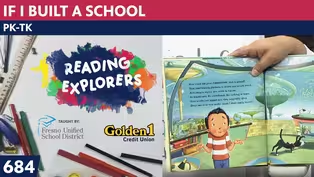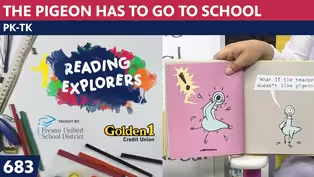
TK-390: The Three Women
Season 3 Episode 506 | 14m 3sVideo has Closed Captions
Join Mrs. Readwright at Camp Discovery!
Join me today as we continue our study of Sonia Delaunay. She is famous for her geometric shape art. Each day we will use a different medium (materials or supplies) to create our art. If you want to create art like "The Three Women" in the style of Sonia Delaunay, bring white paper, a ruler, a pencil, oil pastels, watercolor pencils, watercolors, brushes, water, and paper towels.
Problems playing video? | Closed Captioning Feedback
Problems playing video? | Closed Captioning Feedback
Reading Explorers is a local public television program presented by Valley PBS

TK-390: The Three Women
Season 3 Episode 506 | 14m 3sVideo has Closed Captions
Join me today as we continue our study of Sonia Delaunay. She is famous for her geometric shape art. Each day we will use a different medium (materials or supplies) to create our art. If you want to create art like "The Three Women" in the style of Sonia Delaunay, bring white paper, a ruler, a pencil, oil pastels, watercolor pencils, watercolors, brushes, water, and paper towels.
Problems playing video? | Closed Captioning Feedback
How to Watch Reading Explorers
Reading Explorers is available to stream on pbs.org and the free PBS App, available on iPhone, Apple TV, Android TV, Android smartphones, Amazon Fire TV, Amazon Fire Tablet, Roku, Samsung Smart TV, and Vizio.
Providing Support for PBS.org
Learn Moreabout PBS online sponsorshipMore from This Collection
Valley PBS and Fresno Unified School District have partnered with Golden 1 Credit Union to create Reading Explorers Lessons for grades Pre-Kindergarten through Third grade. The daily lessons will be taught by Fresno Unified School District teachers and are created to help students practice their reading skills and reinforce lessons during distance learning.
Video has Closed Captions
Valley PBS presents Reading Explorers Lessons for Pre-Kindergarten and TK. (26m 27s)
PK-TK-693-The Most Magnificent Thing
Video has Closed Captions
Valley PBS presents Reading Explorers Lessons for Pre-Kindergarten and TK. (26m 26s)
Video has Closed Captions
Valley PBS presents Reading Explorers Lessons for Pre-Kindergarten and TK. (26m 28s)
Video has Closed Captions
Valley PBS presents Reading Explorers Lessons for Pre-Kindergarten and TK. (26m 28s)
PK-TK-690: The Very Clumsy Click Beetle
Video has Closed Captions
Valley PBS presents Reading Explorers Lessons for Pre-Kindergarten and TK. (26m 22s)
PK-TK-689: What Color is the Wind?
Video has Closed Captions
Valley PBS presents Reading Explorers Lessons for Pre-Kindergarten and TK. (26m 21s)
PK-TK-688: Pocket Full of Colors
Video has Closed Captions
Valley PBS presents Reading Explorers Lessons for Pre-Kindergarten and TK. (25m 58s)
PK-TK-687: Dancing Through Fields of Colors
Video has Closed Captions
Valley PBS presents Reading Explorers Lessons for Pre-Kindergarten and TK. (26m 20s)
PK-TK-686: One World Many Colors
Video has Closed Captions
Valley PBS presents Reading Explorers Lessons for Pre-Kindergarten and TK. (27m 13s)
PK-TK-685: School is Wherever I am
Video has Closed Captions
Valley PBS presents Reading Explorers Lessons for Pre-Kindergarten and TK. (26m 32s)
PK-TK-684: If I Built a School
Video has Closed Captions
Valley PBS presents Reading Explorers Lessons for Pre-Kindergarten and TK. (26m 21s)
PK-TK-683: The Pigeon Has to Go to School
Video has Closed Captions
Valley PBS presents Reading Explorers Lessons for Pre-Kindergarten and TK. (26m 22s)
Providing Support for PBS.org
Learn Moreabout PBS online sponsorship(guitar strumming) ♪ Good morning to a brand new day ♪ ♪ Time to learn and games to play ♪ ♪ Learning things is so much fun ♪ ♪ Learning is good for everyone.
♪ (bright playful music) - Hello, early learners.
And welcome back to the art room.
It is our last day going into summer that we're going to be together.
And I wanted to tell you, thank you for joining us.
Thank you for doing art.
Thanks for being excited about art.
Thank you for sending your letters and your pictures and please thank your teachers for joining us.
And you'll see they decorated the studio with balloons.
And then, because they've loved having us here and having Fresno Unified.
Bring their classrooms here in the morning.
And now that we're back in school, we're going to shut down until school starts again.
So I'll see you again then.
But until then, let's finish up our last day with Sonia Delaunay.
When artists were working, I've told you a lot of them started out and had no money.
None.
They didn't sell their art.
They just had to work and try and find ways to make money in order to buy more supplies, to do their art.
Well, Sonia Delaunay was making art and designing fabric and selling fabric.
And then, she became a designer of clothing.
And when her clothes began to sell, she got a lot of money.
And then, she went back to painting some more.
And then, she went back to designing some more.
Well, the picture that I brought today.
The print of her picture is called Three Women and in French it's called Trois femmes, forms, couleurs in which means three women, forms and colors.
And she changed it back to three women because she wanted people to look not only at the clothing but at the women.
And I brought some different colored, skin color.
So you can make your three women without other skin color, you think looks interesting.
And I was going to start out by drawing the three women's shoulders and heads, kind of it does in the picture.
Let's take a look at it.
Here it is.
She has three different dresses and she has several coats that she made with this very design.
And it's not concentric circles because these aren't circles, but these are rectangles.
One, inside the other, inside the other, inside the other.
And you'll notice when she made these women, she has their head and shoulders than a straight line across for the dress and down.
And this one, the head, the shoulders, and straight down.
You can see where the waist is, where she's kind of made it go in a little on this one.
And this one, she made a line to show and then here's the head and shoulders of last one with a straight line.
It's kind of called strapless.
And this one goes to the waist and then it goes out and in, out and in, out and in, like a pine tree.
Feet and hands are difficult to draw.
So she just made some kind of finish rectangles with the little point, like our hand is going out and a hand off of the side of this one.
Then two legs, the same color as her face.
Two legs, a little lighter than the face and then two legs, the color of the face.
So you can decide what kind of dress you want to put on them.
And then afterwards, after you finished the three women, we can make the background.
I probably won't have time but you'll see.
She made a rectangle then she made it stripe, stripe, stripe, stripe, and then across, across, across, across and did a pattern of black teal, black teal, teal black teal, black, black, gray, black, gray.
You can make your buildings however you want.
And then back here, you can see she did another line, line and then stripe, stripe, and down.
And this one was just a solid one with a pink, upper roof.
And how she did this kind of reminds me of the dress we drew yesterday.
Because it's just a lineup of triangles.
So you can decide if you want to use that triangle.
If you saved it from yesterday, you could do that.
So what I'm going to do is first draw the heads.
One, two, three, kind of spaced out and then I'll start drawing the dresses on there.
So let's pull this down (paper rustling) and I'll move my clipboard and my pointer stick off to the side and put this on our table for our inspiration.
Bring my table up.
You'll see, I have a collection of colored pencils, kind of skin color.
A whole array of them.
'Cause every year I bought new pencils for my art class.
(paper rustling) And every year I would put them all.
All the browns I put in one bucket and all the yellows in another.
And then of course, these are my stripy watercolor brushes.
So what I'm going to start out is, I'm going to start out with one of the colored pencils and kind of sketch out (colored pencil scratching) an oval head.
Let me move it on this side (paper rustling) 'cause then my hand isn't as in the way.
Maybe I'll turn this side, this side.
(pencil case clattering) Move the ruler.
So, and then her shoulders are just a little bit of a curve down, down.
She didn't really make a neck and you see on this.
She didn't make any facial features.
(pencil scratching) But if you were to put a eyes, nose, mouth on yours.
That's just fine.
'Cause this is your artwork.
We're just being inspired or getting ideas from Sonia Delaunay.
(colored pencil scratching) So here's person number one.
I'm going to have to remember to put her legs in this color.
But I don't know how far down I'm going to make the dress.
So I'm not going to put the legs on yet.
My next girl has a bit browner skin.
So she's going to have an oval and she's going to be in the middle of my paper.
And so her skin gets colored in brown All the whole oval.
(colored pencil scratching) And you notice, I'm not putting the eyes, nose or mouth on this one, but what did I say?
Do you have to follow this?
No.
But you can decide how you want that.
So now I make the shoulders go down, down.
I'm going to turn this and show you so far where I am.
So that if you can't watch it upside down, it's hard to do art upside down.
I've learned to train myself, to read books upside down but it's much harder to draw upside down.
So here it is.
Here's my kind of tany colored person.
Here's my browner colored person.
And then the next one, maybe I'll make her even, a golden girl.
Because I don't have a peach crayon color but I could color this, this way and then color another color over it later.
(colored pencil scratching) And I'm using the regular colored pencil because I don't want to, it to smear, when I'm painting in the dress.
We're heading needs to be a little bit bigger.
Trying to make everybody's head about the same size.
And go down for her shoulders, and down for her shoulders across and color in her shoulders.
(colored pencil scratching) Yeah.
This is kind of stylized to how we talked about that with Charlie Harper, all his birds were stylized because they were made out of shapes.
Well, my people are pretty much shapey and I brought a regular pencil.
So I can then decide how I'm going to do the dress.
And she made it go in at the waist a little and down and I want room for the legs.
So I'm going to go across.
Kind of looks like an hourglass or have you ever had a sand timer at school?
where your teacher says who gets to use what for however length of time and they turn the sand over.
Here's the hand.
And she made, I might even put a little thumb facing the body.
'Cause I've taught you that.
When people are standing and you can make their, make it look like their hand by putting that little part of her to the side where it's their thumb.
'Cause when you stand, your thumb is not out.
Your thumb is toward your body.
(colored pencil clattering) Now in order to make this be the triangles, I'm going to draw stripes about the same distance apart across on this dress.
And I will draw it with my watercolor pencils.
Maybe I'll make a whole rim of the bottom being blue.
This I'm going to put her two stick legs (colored pencil scratching) and I'll let them go to the end of the paper.
And then, you know how I like to make a frame around it.
I will do that later.
Oh, her legs need to be a little thicker than that.
'Cause she isn't a toothpick.
It's funny how people think when people get really thin, they say, oh, she's as big as a toothpick.
When I play a game at school, when I want children to listen and stand up quickly.
I say toothpick and everyone stands up and puts their hands over their head and makes themselves look like a toothpick.
I'm gonna make the body go down a little longer at the waist 'cause they didn't make it a really short waisted, concentric rectangle dress.
There's her dress.
She's gonna, I can put the other arm in.
On hers, the dress is the people overlapped more, so I can put her other arm on.
Make it the same length as the one over there and then put the hand on it, (colored pencil scratching) color up.
Okay.
Now I'm gonna do a little bit of the drawing so that we can see what my design is going to look like.
Starting from the corner of her dress, I touch the bottom line and go up.
Touch the top, touch the bottom line and go up and touch the bottom line.
So I'll show you what I'm going to do.
Let me get my skinniest little watercolor brush and I think it blue.
But my favorite colors are red or green.
So I'm gonna do red on this one.
(colored pencil scratching) So I'm gonna put red in that triangle and remember what the watercolor brushes.
I can just do it part of it.
I doesn't have to be completely painted colored in.
'Cause when the water touches it?
Put it back in its place.
I'm gonna put a little water down into the brush, so that it's there and I will paint it.
Oh, that's gonna look good.
Might've put a little too much water on it.
'Cause it looks like it wants to drip.
I'll just put it down here.
Now this one, they have it still going down and the point of the white one goes there.
Down, up, down.
(colored pencils clattering) So this one's going to go down, I can still use a little bit of the color from the one over here.
I hope I'm doing this in a good way.
Oh, it made it a little lighter.
'Cause it doesn't have as much pigment from the colored pencil.
Better add a little while or you won't be able to see it.
Use my pencil again and go down, up, down, up, down.
(colored pencils clattering) I'm gonna get that colored pencil and get a little more color in it here.
And I'm coloring the ones that go down.
So I'm gonna put those, making it all white mountains going up.
And the part that goes down is the pink.
Maybe it's like a little sunset.
Well, that's very bright, Okay.
I've gotten started on that.
I wanted you to see how I did that.
I'm going to get the brown and color her legs.
So she also can stand up and not be floating through the air.
Don't make a toothpick leg, this is very bright.
(pencil scratching) Boys and girls, when you were working at home, since this is our last day together, would you try and take a picture of yourself working and send it to me and tell me goodbye.
And the studio will make sure I get the mail.
And you can tell me what was your favorite project we did during the time we were together.
'Cause maybe I'll do something like that.
Next year, when we're working together.
So I like to hear what people like to do or what materials they learned about that they had never used before.
I know a lot of my friends wrote and said that they had never used watercolor pencils before and how fun they are.
And they really are.
It's a nice project to, even if you're taking it in the car in, or for you, we have to go to the doctor's office and you can use them there because they don't make a mess.
I think I better make a few of my rectangles.
Well, maybe I could just do it with that squared off.
One, that girl is going to get some brown colors in there.
Anyway, boys and girls, I have loved spending time with you.
I appreciate all the attention you paid to the art.
And I will see you when school starts up again.
And by then, I'll know what things you really enjoyed doing.
(pencil scratching) So... ♪ Goodbye see you next year everyone ♪ ♪ Goodbye see you next year everyone ♪ ♪ Goodbye to you ♪ ♪ Goodbye to you ♪ ♪ Goodbye to you ♪ ♪ Goodbye to me ♪ ♪ Goodbye see you next year everyone ♪ Boys and girls, thanks again.
And enjoy your summer.
Do well in school.
And I'll see you next year.
Next school year.
Bye-bye (guitar strumming) ♪ Good morning to a brand new day ♪ ♪ Time to learn and games to play ♪ ♪ Learning things is so much fun ♪ ♪ Learning is good for everyone.
♪ (guitar strumming)
Support for PBS provided by:
Reading Explorers is a local public television program presented by Valley PBS
